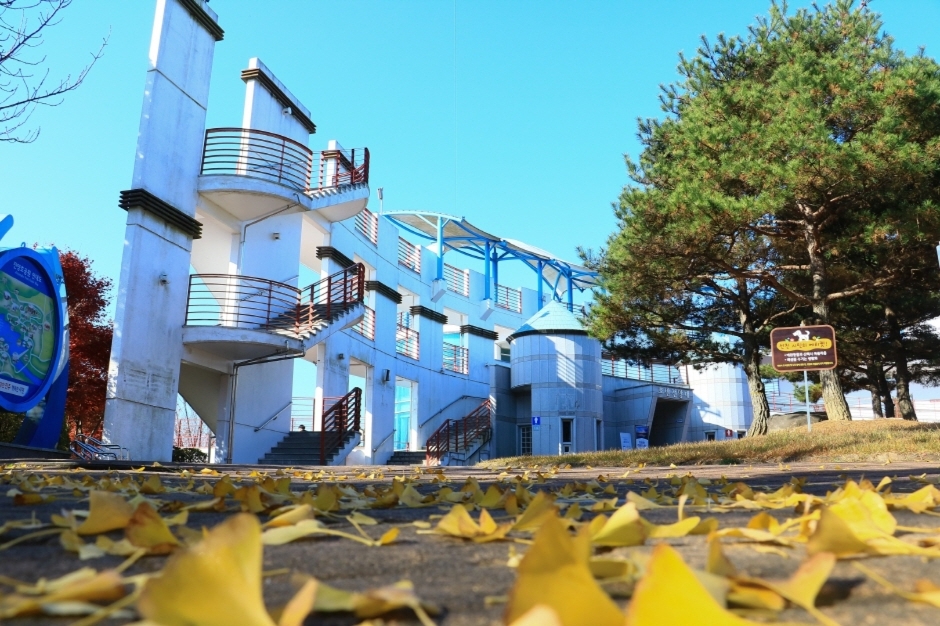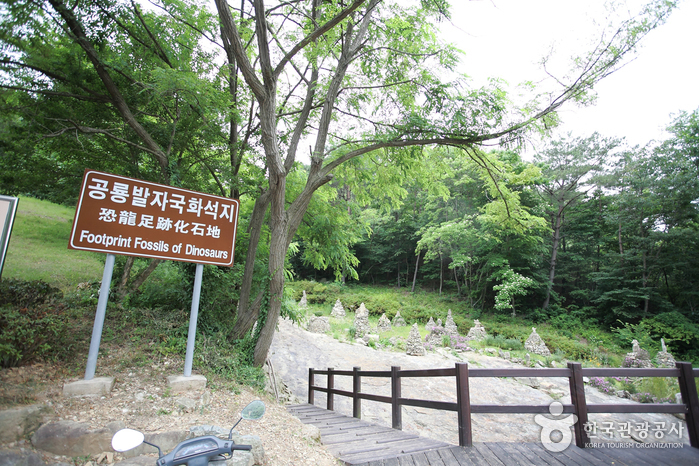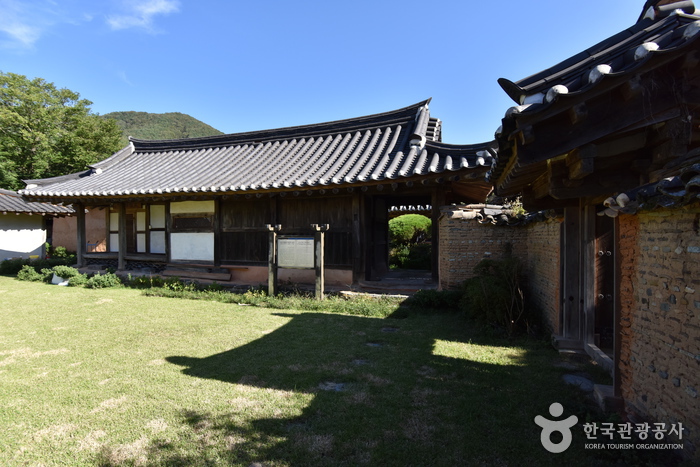Jinju Tongdak (진주통닭)
8.8Km 2024-02-28
15-20 Namgang-ro 29beon-gil, Jinju-si, Gyeongsangnam-do
Jinju Tongdak, nestled near Jinyangho Lake, Jinju, is a restaurant renowned for its chicken specialties. The highlight of their menu is the spicy marinated dakjjim (braised chicken), meticulously prepared with an assortment of vegetables like cabbage, carrots, and lotus root. Available in mild, medium spicy, and spicy options, it caters to a variety of palates. In addtion to their signature dish, the restaurant also serves a range of other delightful choices, including baeksuk (whole chicken soup) and dak bokkeumtang (spicy braised chicken).
Jinju Bullfighting Arena (진주소싸움경기장)
8.8Km 2024-02-28
100 Panmunodong-gil, Jinju-si, Gyeongsangnam-do
Jinju Traditional Bullfighting Arena was established with the aim of preserving and fostering Jinju's traditional folk culture of bullfighting. With a seating capacity of 3,000, the arena is strategically situated in proximity to the expansive Jinyangho Park, seamlessly blending with its picturesque scenery. This venue annually hosts national competitions and holds regular Saturday bullfighting matches, providing visitors with a unique and captivating spectacle.
Jinyangho Park (진양호 공원 (진양호 전망대, 동물원))
9.1Km 2024-08-28
96-6 Namgang-ro 1beon-gil, Jinju-si, Gyeongsangnam-do
Jinyangho Park is situated around Jinyangho Lake, the only manmade lake in Gyeongsangnam-do. The park is complete with a range of facilities and amenities, including a zoo that is home to tigers, lions, bears, eagles, giraffes, and many more animals. Another popular attraction within the park is the observatory, a modern three-story building that offers views of the surrounding landscape. The park has been used as a filming site, and is a common date location for locals.
KAI Aerospace Museum (사천 항공우주박물관)
13.9Km 2024-02-23
78 Gongdan 1-ro, Sanam-myeon, Sacheon-si, Gyeongsangnam-do
KAI Aerospace Museum is dedicated to the preservation and exhibition of materials related to Korea's aerospace science. Its establishment aims to cultivate a proper historical perspective on national security while showcasing the technology and vision of the cutting-edge aerospace industry. Key facilities within the museum include the Freedom Hall, Aerospace Hall, Aviation Industry Hall, and an Outdoor Exhibition Hall. These exhibits not only provide valuable insights into the history of the aviation industry but also offer a glimpse into the future of the space industry.
Gyeongsangnam-do Arboretum (경상남도 수목원)
14.0Km 2024-02-28
386 Sumogwon-ro, Ibanseong-myeon, Jinju-si, Gyeongsangnam-do
Gyeongsangnam-do Arboretum is a botanical garden in Daecheon-ri, Jinju. Spanning an area of 117 hectares, the arboretum includes Special Arboretum, Botanic Garden, and Tropical Botanical Garden, primarily focusing on the flora of Korea's southern region. It preserves and showcases over 3,000 species of domestic and international plants. Complementing these features are a range of essential facilities, including a Theme Center, Experience Center, Ecological Forest, Wildlife Center, and more.
Yeonhwasan Provincial Park (연화산도립공원)
15.1Km 2022-08-03
544, Yeonhwasan 1-ro, Goseong-gun, Gyeongsangnam-do
+82-55-673-4101
Yeonhwasan Mountain, located in Goseong, Gyeongsangnam-do, is just 524 meters tall, encompasses the three peaks of Ongnyeobong, Seondobong and Mangseonbong, and is widely recognized as an important provincial park. Its northern side is dotted with Buddhist temples such as the historical Okcheonsa Temple, Baengnyeonam Hermitage, Cheongyeonam Hermitage and Yeondaeam Hermitage. Although Yeonhwasan Mountain is called a "mountain," the gentle slopes and ridges are more similar to those of a hill. Unlike other mountains where the purpose lies in trekking and climbing to the mountain summit, the most fruitful experience one can get from exploring Yeonhwasan Mountain is a visit to Okcheonsa Temple. From the summit of the mountain, visitors will be able to see Okcheonsa Temple nestled in the mountain and the deep blue sea along Danghangpo Resort to the mountain's south.
Suamsa Temple (수암사)
16.2Km 2024-02-28
267 Suam-ro, Uiryeong-eup, Uiryeong-gun, Gyeongsangnam-do
Suamsa Temple is located on the slopes of Byeokhwasan Mountain in Uiryeong. The approach is a remarkable 650-meter path leading to the Cheonwangmun Gate, flanked by 333 outdoor statues of Avalokitesvara Bodhisattva crafted from jade stone — the largest collection of its kind in Asia. Beyond the Cheonwangmun Gate, the temple grounds unfold, revealing a series of halls. These include the Daejeokgwangjeon Hall with its Gilt-Bronze Ten-Thousand Buddhas, as well as the Geungnakjeon Hall, Gwaneumjeon Hall, and Buddhist Bell Pavilion.
Parkjinsagoga(박진사고가)
16.2Km 2024-06-20
25-12, Cheonggwang 6-gil, Goseong-gun, Gyeongsangnam-do
+82-10-8854-2141
Parkjinsa Gotaek in Cheonggwang-ri,Goseong is an old house of Miryang Park Clan which is #292 Cultural Material. The traditional Korean style house shows the construction method of houses during the late Joseon Dynasty. Three generations of Sungkyunkwan officials were born in this house in a span of 100 years. There is a red gate of award of the king erected at the entrance of the house to cite the devoted son. Usually the red gate of award of the king was erected at the entrance of the village to cite the devoted son, a chaste woman, or a loyal subject, and the Parkjinsa Gotaek is a rare case for which the red gate of award of the king was erected at the entrance of the house.
The old wall of the house, which looks like a fossil bed, demonstrates the long history of the house. The well-tended garden near the gate will make you stop walking because it looks like something straight out of a movie scene. The scenery over the window from any place inside the house is as pretty as a picture. The rooms in the house are composed of 2 Anchae (inner buildings) and 4 Sarangchae (outer buildings). Both Anchae and Sarangchae are equipped with restroom and shower room. The kitchen is only in the Anchae building. Sarangchae can be used as one wide room to accommodate a maximum 10 people; it’s done by simply opening the doors dividing the small rooms. The house is used for paid educational programs of traditional tea ceremony and etiquette. The old warehouse has been remolded to be a classroom for tea ceremony classes. The place is also used as a place for events; it’s equipped with a beam projector and sound equipment for hosting seminars, workshops, etc. There is a tea ceremony room made by remodeling a building attached to Sarangchae where you can learn the wisdom of ancestors over a warm tea.




 English
English
 한국어
한국어 日本語
日本語 中文(简体)
中文(简体) Deutsch
Deutsch Français
Français Español
Español Русский
Русский